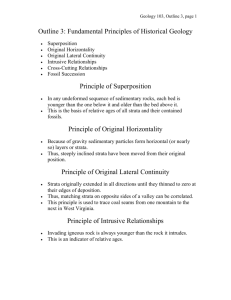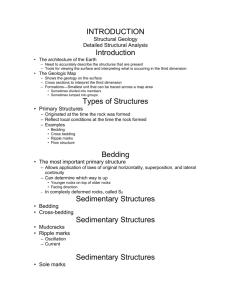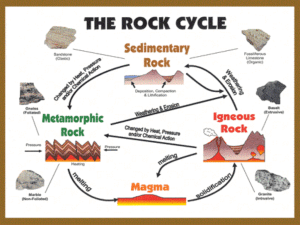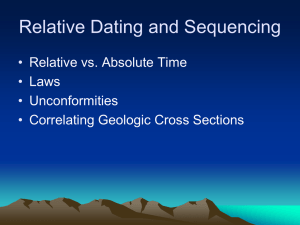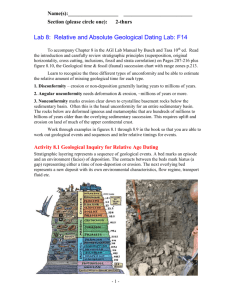Unconformities
advertisement
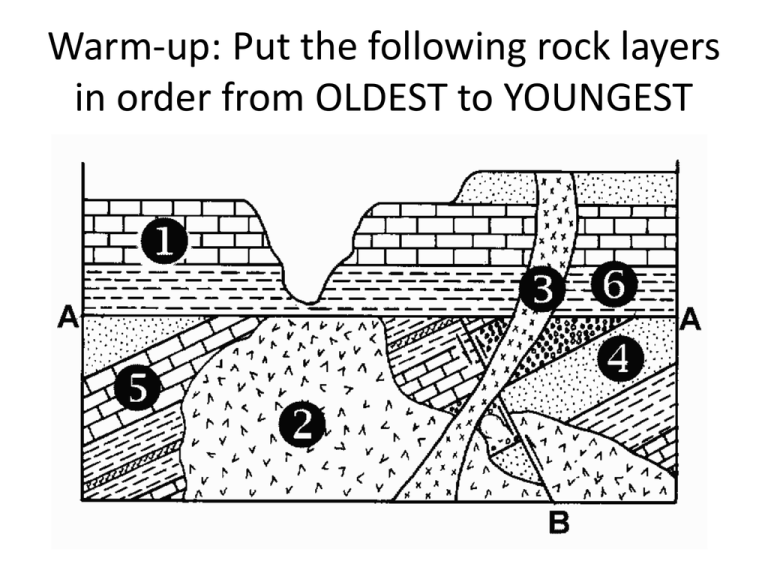
Warm-up: Put the following rock layers in order from OLDEST to YOUNGEST Notes: Steno’s Laws • Essential Question: How can you tell the relative age of geologic events (faults, erosion) and rocks from a cross section? Which is older, 1 or 6? How do you know? • Sedimentary rocks stack from oldest on bottom to youngest on top • First look how each layer is stacked from bottom to top (oldest to youngest) • The deeper a layer is, the older it is • The bottom rock is usually the oldest • In sedimentary rocks the oldest layers are at the bottom 1. Law of Superposition • This rule is called the Law of Superposition: • In an undeformed sequence of sedimentary rocks, each bed is older than the one above it and younger than the one below. Did the layers underneath A form at that angle? How do you know? 2. The Law of Original Horizontality • This rule is called the Law of Original Horizontality: • Layers of sediment are generally deposited in a horizontal position. If we observe rock layers that are flat, it means they have not been disturbed and thus still have their original horizontality. 2. The Law of Original Horizontality However, if rock layers are folded or inclined at a steep angle, they must have been moved into that position by crustal disturbances sometime after their deposition. Which is older, 3 or 1? Which is older, 4 or B? How do you know? • If the rock cuts through the rest of the rocks straight up then it is younger. • If a rock has a fault, unconformity, or igneous going THROUGH it, then that layer is older than the fault, etc. • Faults cannot split rocks in half unless the rocks are already there. • If it overlaps more than one layer, count that layer 1st before the layers it overlapped 3. The Law of Cross-Cutting Relationships • This Rule is called the Law of Cross-cutting Relationships: When a fault cuts through older rocks, or when magma intrudes and crystallizes, we can assume that the fault or intrusion is younger than the rocks affected. In other words, a younger feature cuts through an older feature. Which is older, 2 or 6? How do you know? • Any layers above an unconformity are most likely younger than layers below • Look for unconformity lines: any layers that are on top have been erased • Look for any igneous rocks: where the igneous rock stops is how old it is Line A is called an unconformity An unconformity represents a long period during which deposition ceased, erosion removed previously formed rocks, and then deposition resumed. In other words, it’s a break in the rock record. There are three basic types of unconformities: Angular Unconformities Disconformities Nonconformities What happened here? Unconformities Angular Unconformities An angular unconformity consists of tilted or folded sedimentary rocks that are overlain by younger, more flat lying strata. An angular unconformity indicates that during the pause in deposition, a period of deformation (folding or tilting) and erosion occurred. • http://www.classzone.com/books/earth_scien ce/terc/content/visualizations/es2902/es2902 page01.cfm?chapter_no=visualization What happened here? Unconformities Disconformities In a disconformity, the strata on either side are essentially parallel. Unconformities Disconformities In a disconformity, the strata on either side are essentially parallel. What happened here? Unconformities Nonconformities In a nonconformity, the break separates older metamorphic or intrusive igneous rocks from younger sedimentary strata. Here, younger strata rest upon older, metamorphic or igneous rocks. Unconformities Nonconformities In a nonconformity, the break separates older metamorphic or intrusive igneous rocks from younger sedimentary strata. Here, younger strata rest upon older, metamorphic or igneous rocks. Unconformities The three basic types of unconformities illustrated in the Grand Canyon. Put it all together: What happened here? Figure 11.10 (bottom) angular unconformity disconformity nonconformity
